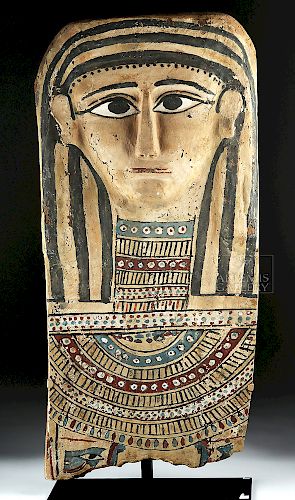Egyptian Painted Gesso & Wood Mummy Mask
Lot 61b
About Seller
Artemis Fine Arts
686 S Taylor Ave, Ste 106
Louisville, CO 80027
United States
Selling antiquities, ancient and ethnographic art online since 1993, Artemis Gallery specializes in Classical Antiquities (Egyptian, Greek, Roman, Near Eastern), Asian, Pre-Columbian, African / Tribal / Oceanographic art. Our extensive inventory includes pottery, stone, metal, wood, glass and textil...Read more
Categories
Estimate:
$15,000 - $20,000
Absentee vs Live bid
Two ways to bid:
- Leave a max absentee bid and the platform will bid on your behalf up to your maximum bid during the live auction.
- Bid live during the auction and your bids will be submitted real-time to the auctioneer.
Bid Increments
| Price | Bid Increment |
|---|---|
| $0 | $25 |
| $300 | $50 |
| $1,000 | $100 |
| $2,000 | $250 |
| $5,000 | $500 |
| $10,000 | $1,000 |
| $20,000 | $2,500 |
| $50,000 | $5,000 |
| $100,000 | $10,000 |
| $200,000 | $20,000 |
About Auction
By Artemis Fine Arts
May 10, 2018
Set Reminder
2018-05-10 10:00:00
2018-05-10 10:00:00
America/New_York
Bidsquare
Bidsquare : Fine Ethnographic / Asian / Ancient Art
https://www.bidsquare.com/auctions/artemis-gallery/fine-ethnographic-asian-ancient-art-3213
Featuring antiquities from around the world including Pre-Columbian, Tribal, Classical, Asian, so much more! Artemis Fine Arts info@artemisgallery.com
Featuring antiquities from around the world including Pre-Columbian, Tribal, Classical, Asian, so much more! Artemis Fine Arts info@artemisgallery.com
- Lot Description
Egypt, Ptolemaic period, ca. 305 to 30 BCE. A large painted gesso over wood mummy mask, featuring the oversized face of the deceased wearing a mummiform wig and a large, multi-stranded pectoral known as a weswkh collar. At the bottom, two Eyes of Wadjet are visible, a symbol of good health and royal power, personifying the goddess Wadjet, one of the earliest Egyptian deities. This was a common symbol, used to protect the deceased in the afterlife. Preserving a likeness of the deceased was crucial to the ancient Egyptian religion and a mask like this one would protect the head. The sides of this example are drilled to allow attachment of the mask to a coffin. The face is slightly raised at chin, nose, ears, and the edges of the wig, giving it a three-dimensional aspect rather than simply being a flat sheet of wood. Size: 14.7" W x 31.85" H (37.3 cm x 80.9 cm); 33.5" H (85.1 cm) on included custom stand.
In the winter of 1889-1890, Sir Flinders Petrie excavated the large Ptolemaic-era cemetery from the ancient town of Gurob, in the Fayum region. Petrie discovered that the dead were buried in unpainted coffins made of thin wood with only carved, mask-like faces like this one for decoration. These masks were attached to the coffins using pegs. Many simply had holes for eyes, with painted eyes, as on this example, being reserved for the nicer coffins.
Masking the dead was a millennia-old tradition in Egypt when this object was made, having been first introduced in the First Intermediate Period (ca. 2181 to 2055 BCE). By giving the deceased this mask, their family members gave them the power to become an idealized form - like a god who had triumphed over death. In the "Book of the Dead," Spell 151, "Spell for the Head-of-Mystery" describes the function of the funerary mask: "Anubis speaks, the embalmer, lord of the divine hall, when he has placed his hands on the coffin of [the deceased] and equipped him with what [he] needs: ‘Hail, O beautiful of face, lord of vision, whom Ptah-Sokar has gathered together and whom Anubis has upraised, to whom Shu gave support, O beautiful of face among the gods!" The mask was part of the important ritual of returning the senses to the mummy, including restoring their vision and ability to speak.
This example looks similar to one at the Virginia Museum of Fine Arts from the same time period: https://www.vmfa.museum/piction/6027262-52014828/
Provenance: private East Coast, USA collection
All items legal to buy/sell under U.S. Statute covering cultural patrimony Code 2600, CHAPTER 14, and are guaranteed to be as described or your money back.
A Certificate of Authenticity will accompany all winning bids.
We ship worldwide and handle all shipping in-house for your convenience.
#132410The very bottom of the piece is lost. Nice preservation of gesso and pigment, with some wear and pitting commensurate with age.Condition
- Shipping Info
-
All shipping is handled in-house for your convenience. Your invoice from Artemis Gallery will include shipping calculation instructions. If in doubt, please inquire BEFORE bidding for estimated shipping costs for individual items.
-
- Buyer's Premium



 EUR
EUR CAD
CAD AUD
AUD GBP
GBP MXN
MXN HKD
HKD CNY
CNY MYR
MYR SEK
SEK SGD
SGD CHF
CHF THB
THB
















